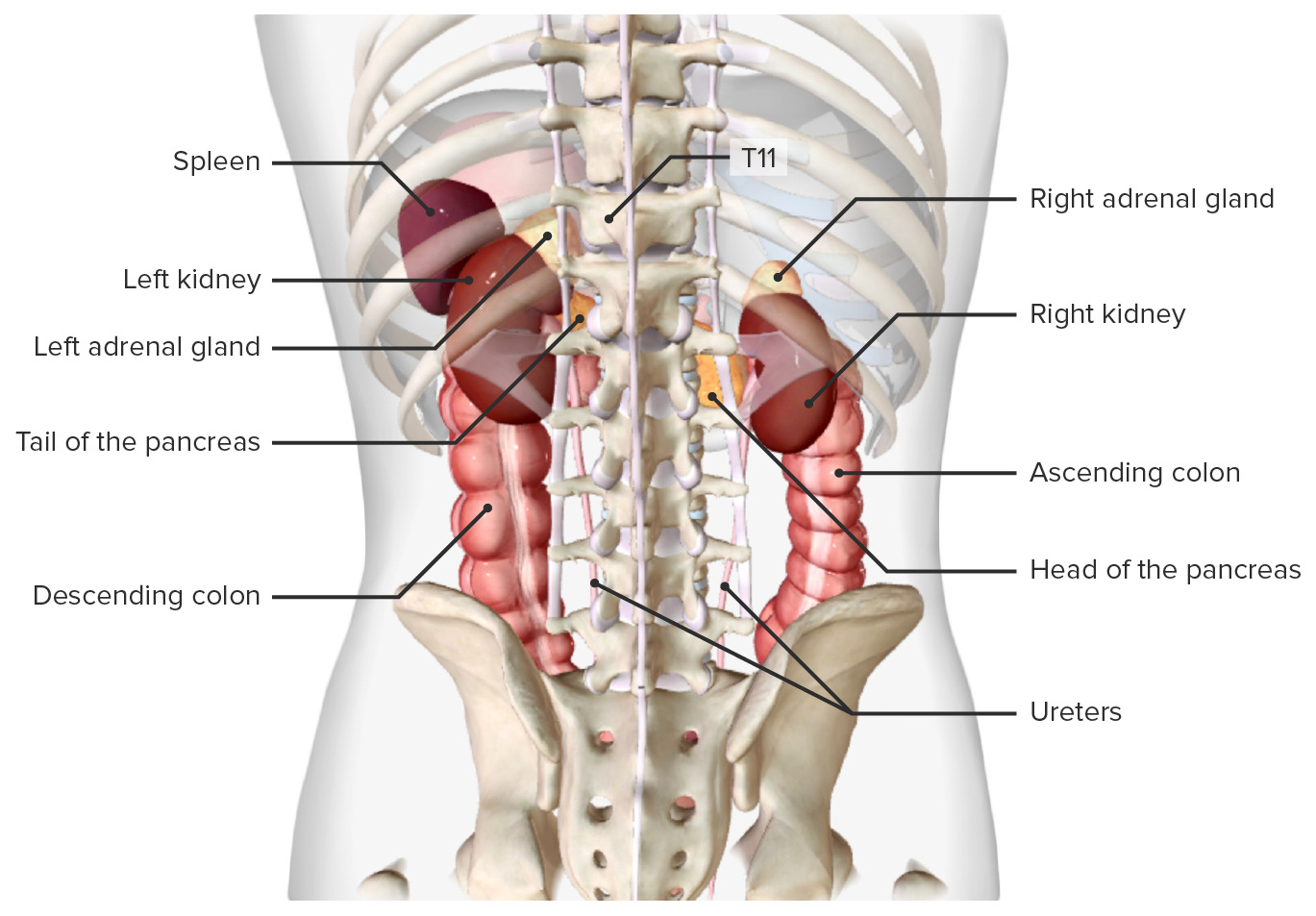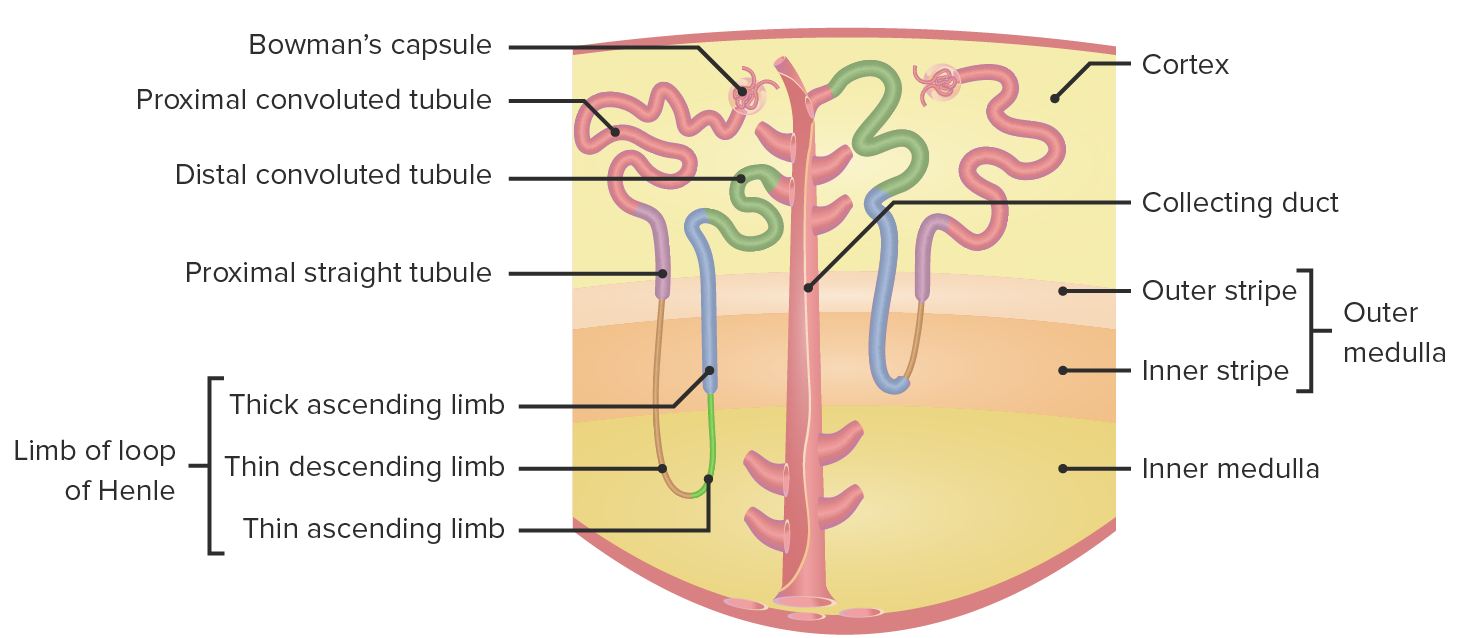Playlist
Show Playlist
Hide Playlist
Starling Forces
-
Slides 02 GFR UrinarySystem.pdf
-
Download Lecture Overview
00:01 If we would calculate things like starling forces in the cardiovascular system, we oftentimes use this kind of equation where J is the flux, [K sub F] is a filtration coefficient, A is a surface area, [P sub C] is the hydrostatic pressure within the capillary, [P sub I] is the hydrostatic pressure within the interstitial space, sigma is the reflection coefficient, the [Pi sub C] is the oncotic pressure of the capillary, and then [Pi sub I] is the oncotic pressure within the interstitial space. 00:41 So this is a very classic way of looking at how fluid travels from the blood into the interstitial space. 00:51 The kidney is no different. 00:52 It’s utilizing this very same principle, but we’re going to only focus on glomerular capillaries rather than capillaries that are located throughout the body. 01:03 So when we break it down to glomerular capillaries, now we’re talking about glomerular filtration rate, so that’s replacing J. 01:12 [K sub F] is the same. 01:14 The area will be consistent, so we can factor that out. 01:18 So we will have [K sub F] is the hydrostatic pressure within the glomerular capillary minus the hydrostatic pressure within Bowman’s space, or also known as the glomerular space. 01:32 The [Pi sub GC] is the glomerular capillarity oncotic pressure, and then the [Pi sub BS] is the oncotic pressure within Bowman’s space, again also known as the glomerular space. 01:47 So this formula works very well looking at how fluid travels across a capillary. 01:55 What are the major principles or players in this? Well, the [K sub F], which is the filtration coefficient -- that’s number 1. 02:03 Then we also have the hydrostatic pressures within both the capillary and within the glomerular space. 02:12 The third thing that’s important is the oncotic pressures, and those would be located both within the glomerular capillary and also in the glomerular space. 02:24 So how do we break down this formula so that it makes more sense intuitively? I think for this one, we can look at an afferent arteriole, the glomerular capillaries, and then the efferent arteriole. 02:39 If we understand how blood flow travels in through this system, and then how much pressure is exerted, we’ll be able to figure out how much filtration actually occurs. 02:52 So let’s use some examples. 02:54 When you start off on the afferent arteriole side, you have a pretty high pressure. 03:00 This hydrostatic pressure within the glomerular capillary right as it enters the afferent arteriole is high - 60 mmHg. 03:10 The oncotic pressure is about 25 mmHg of the oncotic pressure within the glomerular capillary, or [Pi sub GC]. 03:22 As we travel along the capillaries, through the glomerular capillary system, let’s take a midpoint of going through the glomerular capillaries. 03:32 You noticed that hydrostatic pressure didn’t change very much. 03:37 It dropped from maybe 60 to 59. 03:40 But what did change was the oncotic pressure within the glomerular capillary. 03:45 It changed from 25, now to 32, which is a pretty large increase. 03:52 You might ask yourself, “What caused this increase?” Well, if you don’t have as much fluid traveling around, you’re going to concentrate all of your solutes. 04:07 This is exactly what happens. 04:09 You’ve pushed some of the plasma out of the capillary into the Bowman’s space or the glomerular space. 04:16 And what does that leave? More concentrated substances, like proteins, some concentrated substances like cells that increases your oncotic pressure. 04:29 Let’s keep traveling around now towards the end of the glomerular capillary. 04:34 This is right before you get to the efferent arteriole. 04:37 You noticed that pressure again doesn’t change very much, maybe 1 mmHg from the midpoint to the end, going from 59 mmHg to 58 mmHg. 04:48 But once again, there is an increase in oncotic pressure. 04:51 It jumps all the way to 35. 04:53 So there's about a 10 mmHg change in the oncotic pressure between what the glomerular capillaries saw just at the start of the afferent arteriole, to just right at the end before the efferent arteriole. 05:08 The reason that increase happens is because you are concentrating your proteins and your cells within the blood because plasma has left the glomerular capillary and traveled into Bowman’s space. 05:23 Now, let’s do a little bit of comparison between the renal and systemic capillary forces. 05:29 If you remind yourself what the renal forces were, it was glomerular filtration equals the plasma filtration coefficient, multiplied by the pressures within the glomerular capsule, minus the pressure within Bowman’s space. 05:45 We subtract that quantity from the oncotic pressure within the glomerular capillary, minus the oncotic pressure within Bowman’s space. 05:54 So if we look at now a systemic or a normal capillary, we have this type of system. 06:01 We can replace the numbers with now Q just being the flux of water from inside the blood vessel to outside the blood vessel. 06:10 [K sub F] is the same. 06:12 It’s a plasma coefficient. 06:13 But now, the plasma values will be in the capillary versus the interstitial space, versus the oncotic pressure within the capillary, versus interstitial space. 06:26 So let’s look at what happens on the arterial side of a systemic capillary. 06:31 So this is how much water or plasma will be fluxed out of the blood vessel. 06:37 Let’s take an example of the hydrostatic pressure within a capillary of 37. 06:43 We subtract that from the hydrostatic pressure within the interstitial space, which should yield 35. 06:49 We take that number, subtracted from the quantity of the oncotic pressure within the capillary, minus the oncotic pressure in the interstitial space, and that yields 24. 07:01 So then it will be 35 - 24 = +11. 07:06 That means that around 11 mmHg of fluid left the capillary and is out in the interstitial space. 07:16 If we contrast that to the venous side of a normal capillary, this is where the flux is [Q sub V], or the flux of water or plasma, back into the capillary now. 07:31 You take 16 as the pressure in the venous side of the capillary minus 2, which is the pressure in the interstitial space, that should yield 14. 07:44 We subtract that from the quantity of the oncotic pressure within the capillary, which is around 25, minus 1, which is the oncotic pressure within the interstitial space. 07:54 That, again, yields 24. 07:57 So now we have: 14 - 24 = -10. 08:04 So what does a negative number mean? A negative number means the fluid is being pulled back into the capillary. 08:13 So on the arterial side of the circulation, we pushed fluid out. 08:17 On the venous side, we pull it back in. 08:20 But notice these numbers don’t quite equal, do they? There is 1 mmHg of fluid that’s left in the interstitial space. 08:28 That eventually will be picked up by the lymphatic system and brought back into the circulation, but it’s left out in the interstitial space. 08:37 That is the amount of filtration that occurred – 1 mmHg. 08:43 That’s a lot different than the types of glomerular filtration rates we got in the previous examples. 08:49 So once again, showing the difference between the renal capillaries and the systemic capillaries is the amount of filtration. 08:57 There’s much less filtration in systemic capillaries versus the renal capillaries.
About the Lecture
The lecture Starling Forces by Thad Wilson, PhD is from the course Urinary Tract Physiology.
Included Quiz Questions
In the glomerulus, which of the following forces is greatest?
- Glomerular capillary hydrostatic pressure
- Glomerular capillary oncotic pressure
- Bowman’s space hydrostatic pressure
- Bowman’s space oncotic pressure
What happens when fluid is filtered out of the renal capillary into Bowman’s space?
- It increases the oncotic pressure within the glomerular capillary.
- It decreases the oncotic pressure within the glomerular capillary.
- It increases the oncotic pressure within the glomerular space.
- It increases the hydrostatic pressure within the glomerular capillary.
Given the following pressure values, what is the net filtration pressure? The hydrostatic pressure within the capillary = 37mmHg The hydrostatic pressure within the interstitial space = 2mmHg Oncotic pressure within the capillary = 25mmHg Oncotic pressure within the interstitial space = 1mmHg
- 11 mmHg
- 12 mmHg
- 15 mmHg
- 21 mmHg
- 17 mmHg
Which of the following would most likely cause an increase in oncotic pressure in systemic capillaries?
- An increase in plasma protein concentration
- Efferent arteriolar dilation
- A decreased glomerular filtration coefficient
- A decrease in plasma protein concentration
In the equation for GFR, what does a negative Q indicate?
- The fluid is being pulled into the capillary.
- The fluid is being pushed into Bowman's space.
- Proteins are being filtered out of the capillary.
- Proteins are being pullled into the capillary.
- No movement of fluid is observed.
Customer reviews
5,0 of 5 stars
| 5 Stars |
|
1 |
| 4 Stars |
|
0 |
| 3 Stars |
|
0 |
| 2 Stars |
|
0 |
| 1 Star |
|
0 |
Very clear and thoroughly explained! You made a complex concept very simple. Thank you!





